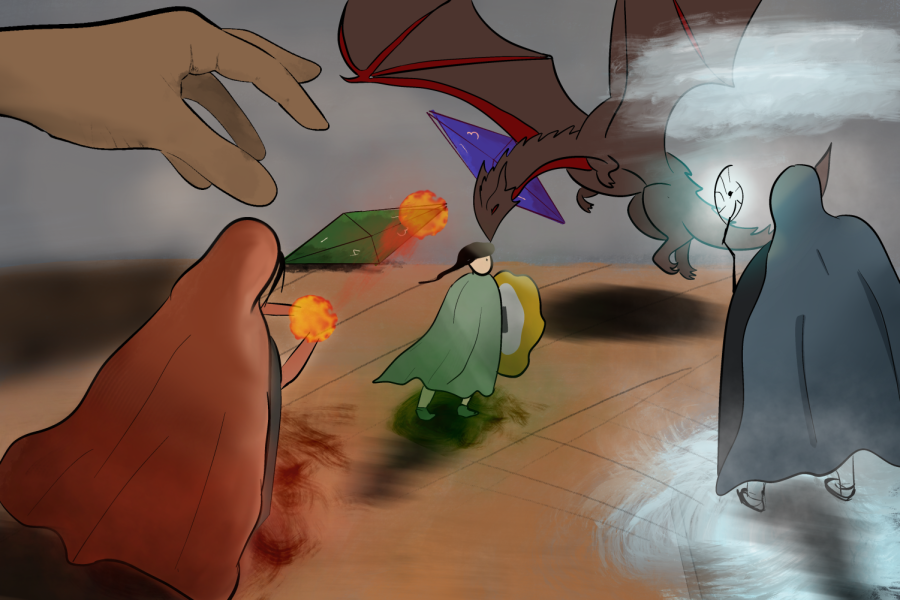Campaigns and controversies: D&D’s lasting legacy
Nearing its 50th anniversary, Dungeons & Dragons continues to impart valuable lessons and experiences to all that partake in its fantastical trials and quests.
May 25, 2023
At the bank of a tranquil, shimmering lake, a motley crew of dwarves, wizards and elves stand tall and mighty, weapons ready. As they plan their next course of action, a tentacle whips out from the center of the lake, breaking the illusion of serenity, and plucks a dwarf from the sand, suspending it in the air. The group rushes to act but cannot move; their actions are left to the hands of fate, or in this case, a set of dice.
This is Dungeons & Dragons (D&D), a tabletop roleplaying game adored by millions across the globe. Nearing its 50th anniversary, the game continues to impart valuable lessons and experiences to all that partake in its fantastical trials and quests.
D&D began as the brainchild of game designers Ernest Gygax and David Arneson in 1974. Initially, the game had limited reach, only producing 1,000 hand-produced copies. Despite its limited availability, adults and teenagers alike began to play the game. D&D is built around the core idea of “campaigns” — groups of players joining together with individually personalized fantasy characters to embark on an odyssey in a medieval world. To create these characters, players customize them using a variety of races, classes and subraces. Some players even decide to bring the game to life by creating costumes to match their characters.
The Dungeon Master — the narrator of the story — leads these characters through a journey of their creation. Characters can ask to explore certain areas further, such as caves, dark passages and cellars, leading to encounters with monsters. During these encounters, players make potentially risky moves, with a set of dice determining the success of these actions. This style of gaming and the creativity and unparalleled freedom afforded by it gained traction. Three years after the publication, the authors published the “Monster Manual,” which added more monsters into the playable world of D&D.
Whitman AP Chemistry teacher Sean Reid first came across Dungeons & Dragons through the “Monster Manual,” and its contents made a lasting impression on him.
“I just started flipping through the guide and looking at all these types of monsters that I had never seen before, even in terms of movies or comic books or anything,” Reid said. “All these monsters were described in such great detail and they had such great pictures that I was fascinated.”
The manual, along with similar introductory D&D campaign books, provided an avenue for people interested in the game to familiarize themselves with the probability mechanics and explore the possibilities of the game. However, despite its positive reception within the fantasy community, Dungeons & Dragons started to gain a negative reputation among children and parents alike.
Stereotypes about D&D formed among youth, characterizing players as socially awkward hermits. The game was viewed as taboo because of its foundations in roleplaying and fantasy — aspects of D&D that initially drew many players in. This newly formed stigma encouraged players to hide their involvement, further reinforcing the anti-social and reclusive stereotypes.
However, the fantastical aspects of D&D garnered a different kind of fear from parents than they had from children. Throughout the 1980s, concerned families accused D&D of promoting satanism, violence and witchcraft as part of a moral panic that swept the nation.
Parents pulled children away from D&D as the amount of violence and the number of deaths by suicide attributed to D&D increased. In 1979, 16-year-old James Dallas Egbert III, an avid D&D player, disappeared in the tunnels under Michigan State University. Although it was a suicide attempt driven by severe depression and sexuality struggles, the media portrayed Egbert’s disappearance as a D&D campaign gone wrong. Writers turned his tragedy into a sensationalized book and movie called Mazes and Monsters. While D&D sales rose after the publication of the novel and movie, the negative perception of the game only worsened.
In 1988, college student Chris Pritchard and his two friends murdered Leith Von Stein, Pritchard’s wealthy stepfather. Police uncovered a D&D game map of the Von Stein house and concluded that the boys planned the murder through a D&D campaign. The validity is unknown, but television and book portrayals promoted the narrative — adding fuel to the fire of D&D wariness.
While these stories on their own were relatively obscure, the dramatization by authors and movie producers alike fostered a lasting negative stigma that persisted until the mid-2010s. In 2016, Netflix released the first season of Stranger Things, a fictional quest to find a young boy taken by monsters. Throughout each season, the screenwriters used Dungeons & Dragons as a parallel to the supernatural events that took place in the series.
This positive press stood in stark contrast to the D&D witch hunts of the past. Instead of watching troubled teenagers struggle because of D&D, children saw relatable characters playing and saving their friend through the game. Seeing a band of likable protagonists using D&D to save their friend developed a more favorable perception of the game
This positive trend continued during the COVID-19 pandemic when the game developed an online platform. Online campaigns provided a place for D&D enthusiasts worldwide to join a game, particularly benefiting those who loved the game but lacked a group to play with. D&D sales matched its expanded availability, increasing by 33% in 2020.
At Whitman, Sophomore Emily Charlton found the game through the Pyle D&D after-school club. She chose to stick with it for the friends she made and the creative outlet it provided, she said.
Junior Naomi Ahrens, the Vice President of the Whitman D&D club, became involved with the game similarly. They enjoy the freedom of expression the game allows and how it has improved their creative writing outside of school.
“A big portion of [D&D] is creative writing,” Ahrens said. “I feel like I’ve learned what people are interested in, what they want and the selection of detail that they’ll pay attention to.”
The cooperation and creativity required to be successful in the game attracts more than just teenagers. Many professional organizations find D&D to be a good facilitator for team building. Forbes, LinkedIn and Mentor Works found that D&D creates a non-judgemental environment for team members to use individual strengths and weaknesses to work collaboratively to best achieve their goals.
While D&D has a conflicted legacy, the camaraderie it fosters builds a sense of community among players. People join the Dungeons & Dragons fanbase for the gameplay, but they stay for the world it unlocks.










